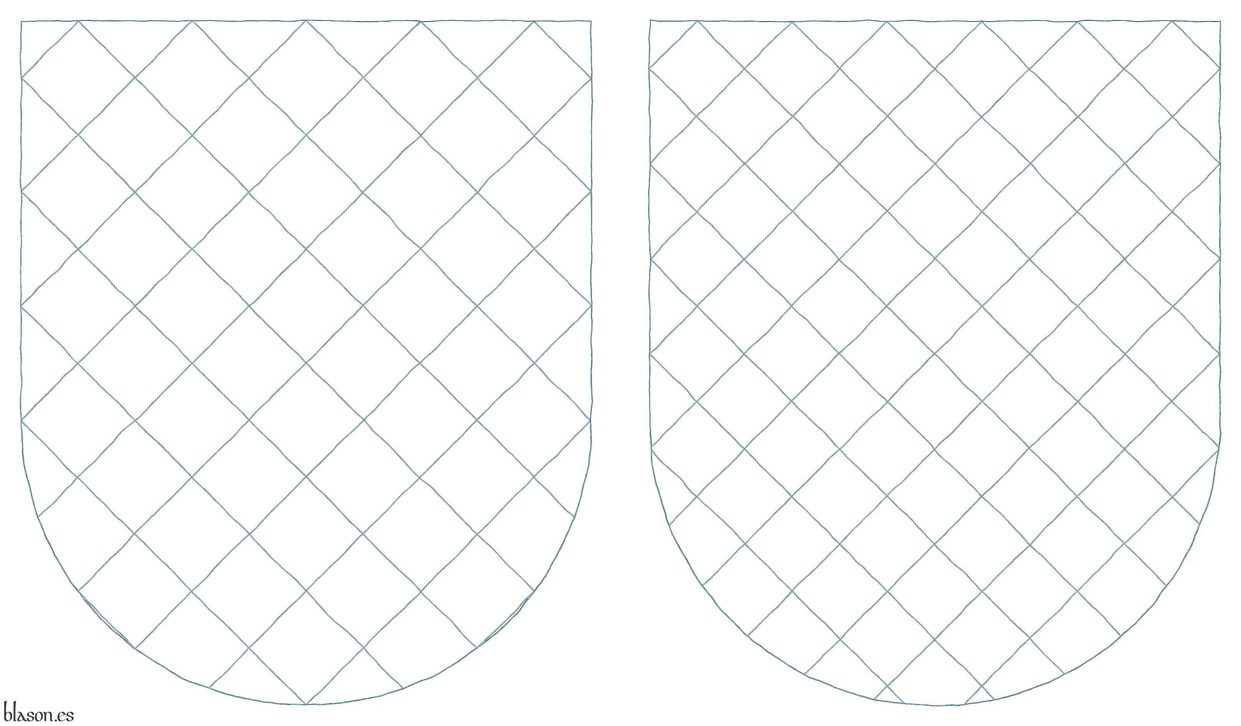Lozenge


Asuncion and de la Asuncion, lineages
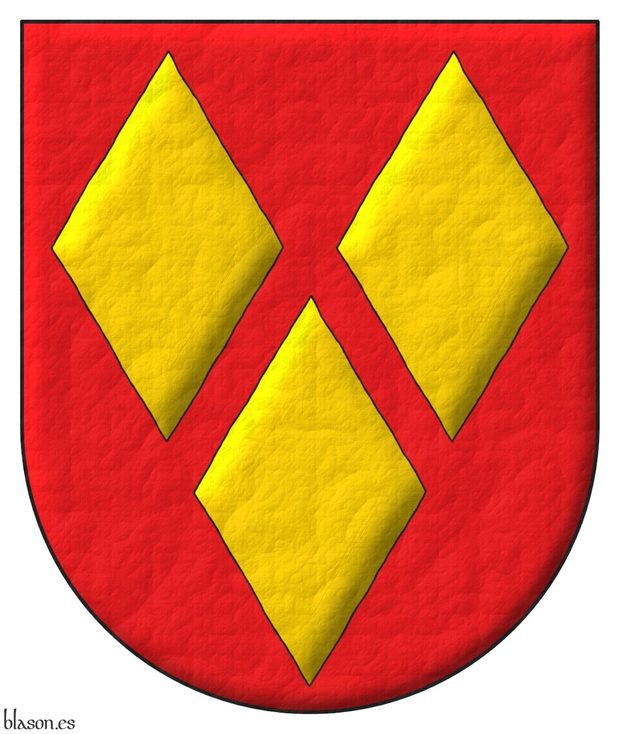
Gules, three lozenges Or.
Escudo de gules, tres losanjes de oro.
Arms painted by me, highlighted with lights and shadows, outlined in Sable, with a semi-circular external shape and with a leather finish.
Coat of arms of the lineages Asuncion and de la Asuncion emblazoned by me.
Blazon keywords: Gules, Or, Three and Lozenge.
Style keywords: Outlined in sable, Illuminated, Semi-circular and Leather.
Classification: Personal, Interpreted, Boa and Coat of arms.
Bearer: Asuncion and de la Asuncion, lineages.


![Ver [Bosque, J. del; 1540] en referencias bibliográficas. Libro abierto, hojas de plata, filo de oro, guardas de gules, tapas de sable.](../css/Libro.Bibliografia.png)
Bosque, J. del; 1540
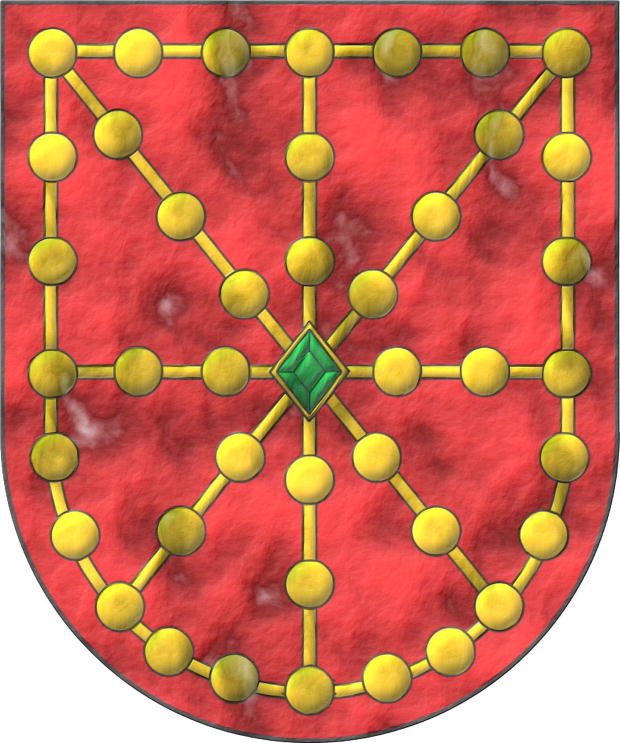
Juan del Bosque, «Libro de Armería del Reino de Navarra», which is currently missing and whose subsequent copy, commissioned in 1572, is kept in the Royal and General Archive of Navarre, estimated year of creation 1540.
The origin of this armorial dates back to 1527, when the Navarrese Courts requested that the Royal Council and the Chamber of Comptos ~ Chamber of Accounts and Fiscal Control, record in a book the coats of arms of the kingdom of Navarre starting with that of the king of Navarre and the houses and lineages of the so-called «ricoshombres», Almorrabides, Guebara, Aybar, Baztanes, Urroz, Lete, Subiça, Rada, Vidaurre, Qasqante, Monteagudo, and Mauleón, also including the coats of arms of other manors, houses, valleys, towns, and nobles [Valverde Ogallar, P. B.; 2001; page 326].
According to [Martinena Ruiz, J. J.; 1982; page 35] the book was compiled around the year 1540, and this is the date I use for referencing this armorial.
This first manuscript created by Juan del Bosque was taken by the royal visitor Hernán Suárez de Toledo, under the pretext of taking it to Emperor Charles V, despite being requested back by the Navarrese Courts, it was never returned and was definitively lost. The armorial that has come down to us is a recreation commissioned in 1572 [Valverde Ogallar, P. B.; 2001; page 327].
According to [Menéndez Pidal de Navascués, F.; 1974; page 19] the recreation of this armorial was carried out based on certifications, such as those from the herald Azcárraga, and notes and partial copies of the stolen book, like the copy kept in the monastery of Leyre.
Another noteworthy bibliographic reference about this armorial, in addition to those previously mentioned, is [Martinena Ruiz, J. J.; Menéndez Pidal de Navascués, F.; 2001].
The image illustrating this bibliographic reference is the coat of arms of the king of Navarre, which I recreated based on the illustration in this armorial, on its first folio according to the numbering given to it in 1613.
Bibliographical reference of century XVI.
Author: Bosque, Juan del.
Here are the articles quoting this reference:
- Almorrabides of Navarre
- Aybar of Navarre
- Baztanes of Navarre
- Guebara of Navarre
- Lete of Navarre
- Martinena Ruiz, J. J.; 1982
- Martinena Ruiz, J. J.; Menéndez Pidal de Navascués, F.; 2001
- Mauleón of Navarre
- Menéndez Pidal de Navascués, F.; 1974
- Menéndez Pidal de Navascués, F.; 1985
- Menéndez Pidal de Navascués, F.; Martínez de Aguirre, J.; 2000
- Monteagudo of Navarra
- Navarra, closed carbuncle
- Navarre
- Noblemen of Navarre
- Qasqante of Navarre
- Rada of Navarre
- Subiça of Navarre
- Urroz of Navarre
- Vidaurre of Navarre


Dimidiation vs. impalement, comparative schema
Dimidiation~dimidiated vs impalement~impaled.
Blazons
- Azure, a lozenge Argent.
- Argent, a fleur de lis Azure.
- Dimidiated: 1 Azure, a lozenge Argent; 2 Argent, a fleur de lis Azure.
- Party per pale: 1 Azure, a lozenge Argent; 2 Argent, a fleur de lis Azure.
Blazon keywords: Dimidiated, Party per pale, Azure, One, Lozenge, Argent and Fleur de lis.
Style keywords: Outlined in sable.
Classification: Schema and Coat of arms.


Gutiérrez Benítez, Jose Manuel
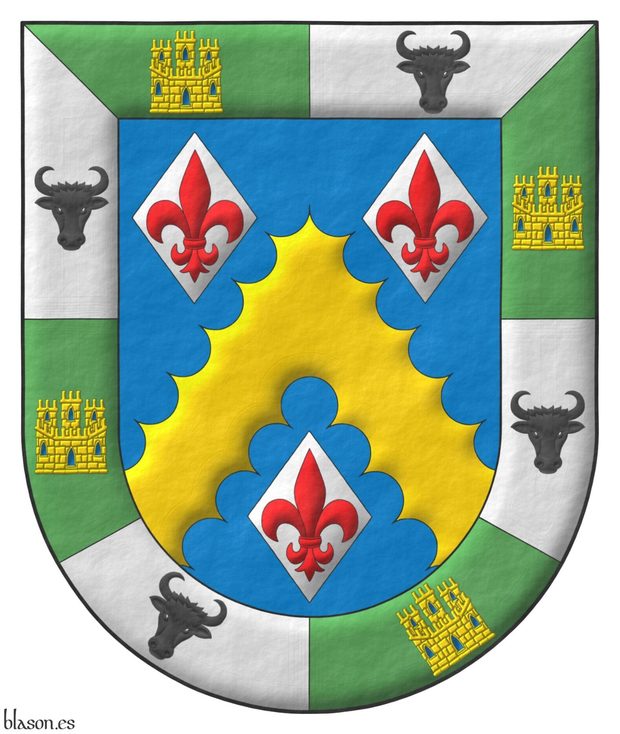
Azure, a chevron engrailed Or between three lozenges Argent, each charged with a fleur de lis Gules; a bordure compony of eight sections, four Vert each charged with a castle triple-towered Or, port and windows Azure, masoned Sable, and four Argent each charged with a bull's head caboshed Sable.
Escudo de azur, un cabrio angrelado de oro acompañado de tres losanges de plata, cada uno cargado de una flor de lis de gules; una bordura componada de ocho compones, cuatro de sinople, cargados cada uno de un castillo de oro, aclarado de azur, mazonado de sable, y cuatro de plata, cargados cada uno de un rencuentro de toro de sable.
Arms devised by me, illuminated with lights and shadows, contoured in Sable, with a semi-circular outer contour and with a rough finish.
This is the coat of arms of Jose Manuel Gutierrez Benitez designed by him and me and emblazoned by me.
Blazon keywords: Azure, Or, Argent, Gules, Vert, Sable, One, Three, Four, Eight, Chevron, Engrailed, Lozenge, Fleur de lis, Bordure, Compony, Castle, Triple-towered, Port and windows, Masoned, Bull, Head and Caboshed.
Style keywords: Outlined in sable, Illuminated, Semi-circular and Rough.
Classification: Personal, Created, Boa and Coat of arms.
Bearer: Gutiérrez Benítez, Jose Manuel.


Jason Landers Northam, hand-drawn
A lozenge Or, charged with a fox rampant, guardant, holding in its dexter paw a federschwert bend sinisterwise proper, within a bordure Vert.
Heraldic badge of Jason Landers Northam from Illinois. The image combines a photograph of a drawing of a fox rampant, guardant, holding in its dexter paw a federschwert bend sinisterwise, together with his badge shown both in plain tinctures and with lights and shadows, all painted by me.
Blazon keywords: Or, Vert, One, Lozenge, Fox, Rampant, Guardant, Federschwert, Sword, Proper, Within and Bordure.
Style keywords: Outlined in sable and Illuminated.
Classification: Personal, Interpreted, Boa, Hand-drawn, Collage and Photographic.
Bearer: Northam, Jason Landers.


Lasuncion Patus, Francisco Javier

Gules, three lozenges Or; a bordure lozengy Gules and Or.
Escudo de gules, tres losanjes de oro; una bordura losanjada de gules y oro.
Arms devised by me, highlighted with lights and shadows, outlined in Sable, with a semi-circular external shape and with a leather finishing.
Coat of arms of Javier Lasuncion Patus designed by him and me and emblazoned by me.
Design rationale
The field is Gules with charges of Or, as in the coats of arms of the lineages Asuncion and de la Asuncion and lineage Patus. In both lineages, there are three well-ordered Or elements, 2 and 1. The lozenges come from the first lineage and are complemented by a lozengy border. The lineage Patus, instead of three lozenges, features three fleurs de lis on a field of Or.
Blazon keywords: Gules, Or, One, Three, Lozenge, Lozengy and Bordure.
Style keywords: Outlined in sable, Illuminated, Semi-circular and Leather.
Classification: Personal, Created, Design rationale, Boa and Coat of arms.
Bearer: Lasuncion Patus, Francisco Javier.


Lozengy 5x6 and 6x7
There are 2 rhombuses in heraldry: the lozenge and the fusil. I like to represent the lozenge, which is a less elongated rhombus than the fusil, as a square with its 2 diagonals placed one vertically and the other horizontally. Lozengy and fusilly consist of filling the entire space with lozenges, in the first case, or with fusils, in the second case, joined 4 by 4 at their corners.
[Avilés, J.; 1780a; page 25] writes «Fusils, Lozenges, and Mascles can be accolados, when they touch with their flanks; and to be so called, the entire Shield must not be filled with these figures, because in that case it would be called Fusilly, or Fuselado and Lozengy.».
In this case, two lozengy schemata of lozenges are presented with their 4 angles at 90o, the first 5 wide by 6 high, which is exact because the angles are 90o and it matches the 5x6 dimensions of the coat of arms and the second 6 wide by 7 high, which may be more suitable for shields that resemble the structure of per pale of three.
In [Cadenas y Vicent, V. de; 1987] one can see written both «losange» with «g» and «losanje» with «j», although the occurrences of «losange» with «g» are more than double those of «losanje» with «j».
In [Royal Spanish Academy; 2014] only the term «losange» with «g» is recorded, it says it comes from the French «losange» and defines it as «a rhombus figure placed so that one of the acute angles is at the base and its opposite at the top.».
Blazon keywords: Lozengy and Lozenge.
Style keywords: Semi-circular.
Classification: Schema.


Lozengy, comparison between 5x6 and 6x7
Comparison between lozengy of 5x6 lozenges and 6x7 lozenges based on the coats of arms of Thomas de Warbrentone and of Pierre de Forcade. It can be observed that, for example, in the case where there is a central pale of Gules, this fits better over the metal Or in the lozengy of smaller lozenges, the 6x7 one, than in the lozengy of larger lozenges, the 5x6 one.
Blazon keywords: Lozengy and Lozenge.
Style keywords: Semi-circular.
Classification: Schema.


Luis Gerardo Oyervides Ochoa, ratios

Sable, a kapok tree eradicated and fructed between in base two lozenges Argent.
Ratios of the coat of arms of Luis Gerardo Oyervides Ochoa, Mexico, designed and outlined by me.
Blazon keywords: Kapok tree, Tree, Eradicated, Fructed, Between, In base and Lozenge.
Style keywords: Ratio and Semi-circular.
Classification: Personal, Created, Boa and Coat of arms.
Bearer: Oyervides Ochoa, Luis Gerardo.


Navarre
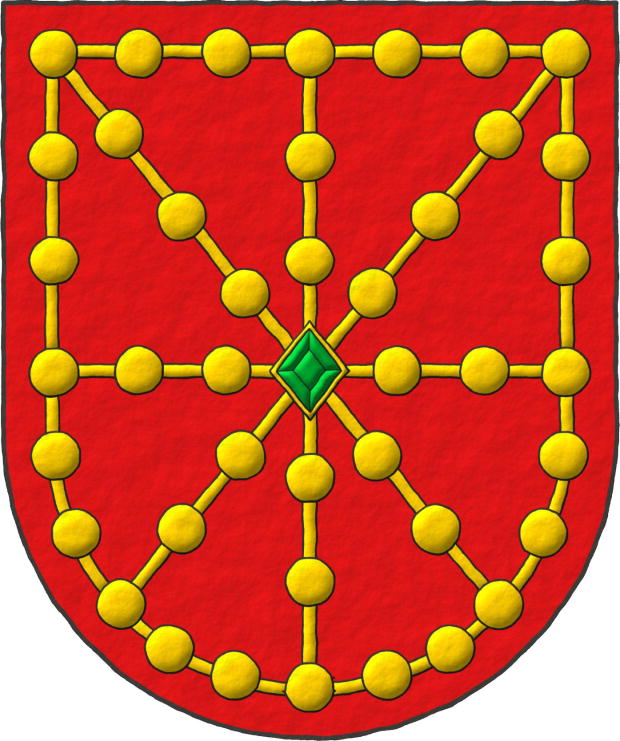
Escudo de gules, un carbunclo cerrado, pomelado de oro; cargado en el centro de una esmeralda en forma de losange de sinople.
Original coat of arms of Navarre interpreted with: a semicircular (round) base; the field in flat Gules; the pommetty carbuncle illuminated in Or and outlined in Sable; the emerald illuminated in Vert and also outlined in Sable; and the whole finished with a raised-stroke effect.
In the armorial [Urfé; Siglo XV; indexed on folio 151, but actually written on 142] the arms of Navarre are blazoned in French as «de gueles à l'escarboucle d'or pommelée alumée de sinoble en la moyenne en guise d'esmeraude», it only gives the blazon, since this armorial is not illustrated.
An image of the original French blazon text can be seen in the article Blazon of Navarre in the Urfé armorial.
The interpretation of the arms of Navarre shown here is based on the one illustrated in the armorial [Bosque, J. del; 1540; folio 1 of the 1613 numbering], which is its main plate, with the arms of the king of Navarre surrounded by the coats of arms of the lineages and manors of his «ricoshombres», twelve lineages in total.
In [Menéndez Pidal de Navascués, F.; 1963] one can consult his view on what is, probably, the real origin of the arms of Navarre, which he bases on:
- The existence of a defensive element of the shield called the boss, placed at its center. This element already existed in classical Rome, on the shields of the legionaries and, in addition, it could serve to keep small valuables inside.
- The later reinforcement of this boss with 8 spokes, that is, 4 diameters set vertically, horizontally, bendwise and bendwise sinister, giving rise to a radiated boss to strengthen the shield.
- This radiated boss on rich shields could be very elaborate and even be adorned with gems, thus becoming an ornamental element.
- The evolution of the radiated boss from a defensive and ornamental element to the so-called carbuncle, but now as a heraldic element with a radial structure. Originally the carbuncle was a mystical stone, comparable to the ruby, that emitted an intense light capable of illuminating the knight in the darkness of night. Heraldically the name carbuncle is used to denote a scheme of radial rays and not the marvellous stone that emitted them and from which it borrows its name.
- This eight-rayed carbuncle, joined at the ends forming a closure, like an orle, and decorated with pommels, on a field Gules, and with an emerald overall at its center is what constitutes the arms of Navarre.
Regarding the importance of the radiated boss and the carbuncle, not only in the arms of Navarre but in heraldry in general, [Menéndez Pidal de Navascués, F.; 1963] goes a step further when he writes «although it has never been pointed out, it seems evident to us the influence of this piece on the classic partitions of the shield, contained in the four diametral lines that compose it». He makes us see that «cortado, partido, tronchado y tajado» and, therefore also, «cuartelado, en sotuer y jironado», do not have their origin in the different ways of striking a shield with a sword, as illustrated, for example, in [Avilés, J.; 1725a; plate 18, illustrations 23, 24, 25 and 25], but in different ways of selecting, as delimiters, the four diameters of the carbuncle.
Blazon keywords: Without divisions, Gules, One, Carbuncle, Pommelled, Or, Charged, In the fess point, Emerald, Vert and Lozenge.
Style keywords: Freehand, Illuminated and Outlined in sable.
Classification: Interpreted, Civic and Coat of arms.
Bearer: Navarre.


Sneddon, Jon
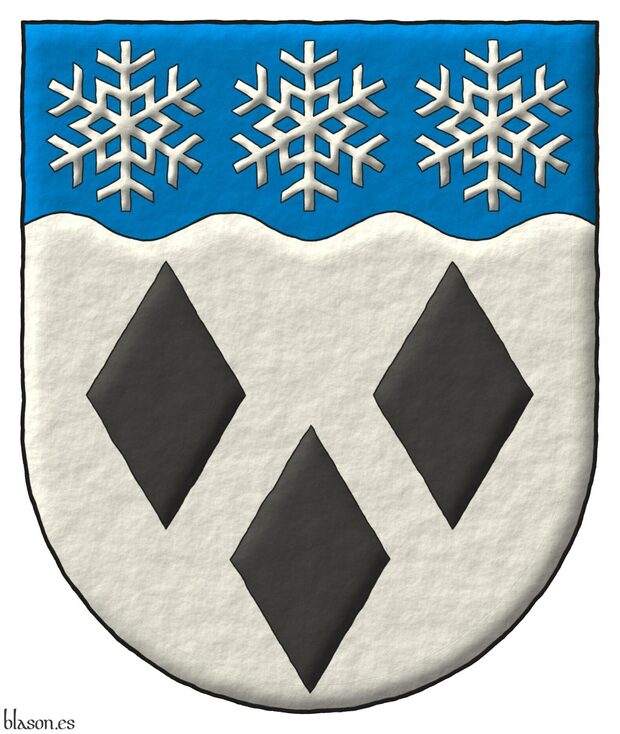
Argent, three lozenges Sable; on a chief wavy Azure, three snowflakes Argent.
Escudo de plata, tres losanjes de sable; en un jefe ondeado de azur, tres copos de nieve de plata.
Arms depicted by me, illuminated with lights and shadows, contoured in Sable, with a semi-circular external shape and with a freehand finish.
Coat of arms of Jon Sneddon emblazoned by me.
Blazon keywords: Argent, Sable, Azure, Three, Lozenge, Chief, Charged, Wavy, Snowflake and Ordered.
Style keywords: Outlined in sable, Illuminated, Semi-circular and Freehand.
Classification: Personal, Interpreted, Boa and Coat of arms.
Bearer: Sneddon, Jon.
-
Language
-
Categories of heraldry
-
Divisions of the field
- Without divisions
- Party per pale
- Party per fess
- Party per bend
- Party per bend sinister
- Tierce
- Tierce sinister
- Tierced per pale
- Tierced per fess
- Tierced per bend
- Tierced pallwise inverted
- Quarterly
- Quarterly per saltire
- Gyronny
- Party per fess, the chief per pale
- Party per pale, the sinister per fess
- Party per fess, the base per pale
- Party per pale, the dexter per fess
- Chapé
- Chaussé
- Embrassé
- Contre-embrassé
- Party per chevron
- Enté
- Enté en point
- Flanched
-
Metals
-
Colours
-
Furs
-
Other tinctures
-
Ordinaries and sub-ordinaries
-
Diminutives of the ordinaries
-
Geometric charges
-
Composite ordinaries
-
Inanimate charges from Nature
Atom, Crescent, Diamond, Emerald, Estoile, Increscent, Lightning flash, Moon, Mount, Mullet, Mullet of four points, Orbital, Plough of Ursa Major, Rainbow, Ray of the sun, River, Sea, Snowflake, Sun, Sun in splendour, Sun of May, Trimount, Water and Wave.
-
Vegetal charges from Nature
Acorn, Apple, Apple tree, Ash, Bluebonnet, Camellia, Chrysanthemum, Cinquefoil, Cornflower, Dogwood flower, Double rose, Elm, Fleur de lis, Flower, Gourd, Holm oak, Hop cone, Kapok tree, Laurel, Lily, Linden, Lotus flower, Madonna lily, Mexican cedar tree, Oak, Olive tree, Palm tree, Plantain plant, Pomegranate, Poplar leaf, Rose, Shamrock, Sunflower, Thistle, Tree, Tulip, Vine and Wheat.
-
Animal charges from Nature
Badger, Bald eagle, Barbel, Barn owl, Bear, Beaver, Beetle, Bighorn sheep, Blackbird, Boar, Brach hound, Bull, Doe, Dog, Dolphin, Dove, Eagle, Elephant, Falcon, Female figure, Fish, Flame, Fly, Fox, Frog, Goat, Goldfinch, Goose, Heron, Horse, Hummingbird, Jaguar, Lark, Leopard, Lion, Lion passant, Lion rampant guardant, Lioness, Lynx, Male figure, Martlet, Merino ram, Owl, Panther, Parrot, Peacock, Pelican, Pelican in her piety, Puffin, Quetzal, Raven, Roe deer, Rooster, Savage, Seagull, Serpent, She-wolf, Stag, Starling, Talbot, Tyger, Vulture, Warren hound and Wolf.
-
Parts of natural charges
Arm, Beak, Branch, Caboshed, Chest, Claw, Covert, Dorsal fin, Eagle claw, Ermine spot, Escallop, Feather, Foot (palmiped), Foreleg, Forepaw, Hand, Head, Heart, Hoof, Leaf, Neck, Ostrich feather, Palm frond, Paw, Roe deers' attires, Shoulder, Sprig, Stags' attires, Stem, Swallow-tail, Tail, Tail addorsed, Tail fin, Talon, Tooth, Trunk, Trunk (elephant), Two hands clasped, Two wings in vol, Udder, Wheat spike, Wing and Wrist.
-
Artificial charges
Ace of spades, Anchor, Anvil, Arch, Arm vambraced, Armillary sphere, Arrow, Axe, Bell, Bell tower, Beret, Bonfire, Book, Bookmark, Bow, Branding iron, Bridge, Broken, Buckle, Cannon, Cannon dismounted, Cannon port, Canopy roof, Carbuncle, Castle, Celtic Trinity knot, Chain, Chess rooks, Church, Clarion, Clay pot, Closed book, Club, Column, Comb, Compass rose, Conductor's baton, Cord, Covered cup, Crozier, Crucible, Cuffed, Cup, Cyclamor, Dagger, Double vajra, Drum, Ecclesiastical cap, Fanon, Federschwert, Fleam, Four crescents joined millsailwise, Galician granary, Garb, Gauntlet, Geometric solid, Grenade, Halberd, Hammer, Harp, Host, Hourglass, Key, Key ward, Knight, Knot, Lantern, Letter, Line, Loincloth, Menorah, Millrind, Millstone, Millwheel, Monstrance, Mortar, Mullet of six points pierced, Nail, Non-classic artifact, Norman ship, Number, Oar, Oil lamp, Open book, Page, Pair of scales, Parchment, Pestle, Piano, Pilgrim's staff, Plough share, Polish winged hussar, Port, Portcullis, Potent, Quill, Ribbon, Rosette of acanthus leaves, Sabre, Sackbut, Sail, Scroll, Scythe, Sheaf of tobacco, Ship, Skirt, Spear, Spear's head, Stairway, Star of David, Step, Sword, Symbol, Tetrahedron, Torch, Tower, Trident, Trumpet, Turret, Two-handed sword, Wagon-wheel, Water-bouget, Wheel, Winnowing fan and With a turret.
-
Immaterial charges
Angel, Archangel, Basilisk, Dragon, Dragon's head, Garuda, Golden fleece, Griffin, Heart enflamed, Justice, Mermaid, Our Lady of Mercy, Ouroboros, Paschal lamb, Pegasus, Phoenix, Sacred Heart of Jesus, Saint George, Sea-griffin, Trinity, Triton, Unicorn, Winged hand and Wyvern.
-
External elements
-
Heraldic creations
-
References
-
Formats
-
Keywords on this page
Port and windows, Between, Proper, Engrailed, Eradicated, Asuncion and de la Asuncion, lineages, Azure, Bibliography, Boa, Bordure, Head, Chevron, Carbuncle, Charged, Castle, Kapok tree, Collage, Compony, Snowflake, Created, Four, Triple-towered, Outlined in sable, Within, Hand-drawn, Dimidiated, In the fess point, In base, Coat of arms, Emerald, Schema, Fleur de lis, Personal, Gules, Illuminated, Interpreted, Lozenge, Lozengy, Semi-circular, Or, Leather, Argent, Without divisions, Pommelled, Sable, Vert, Freehand, Three and One.



